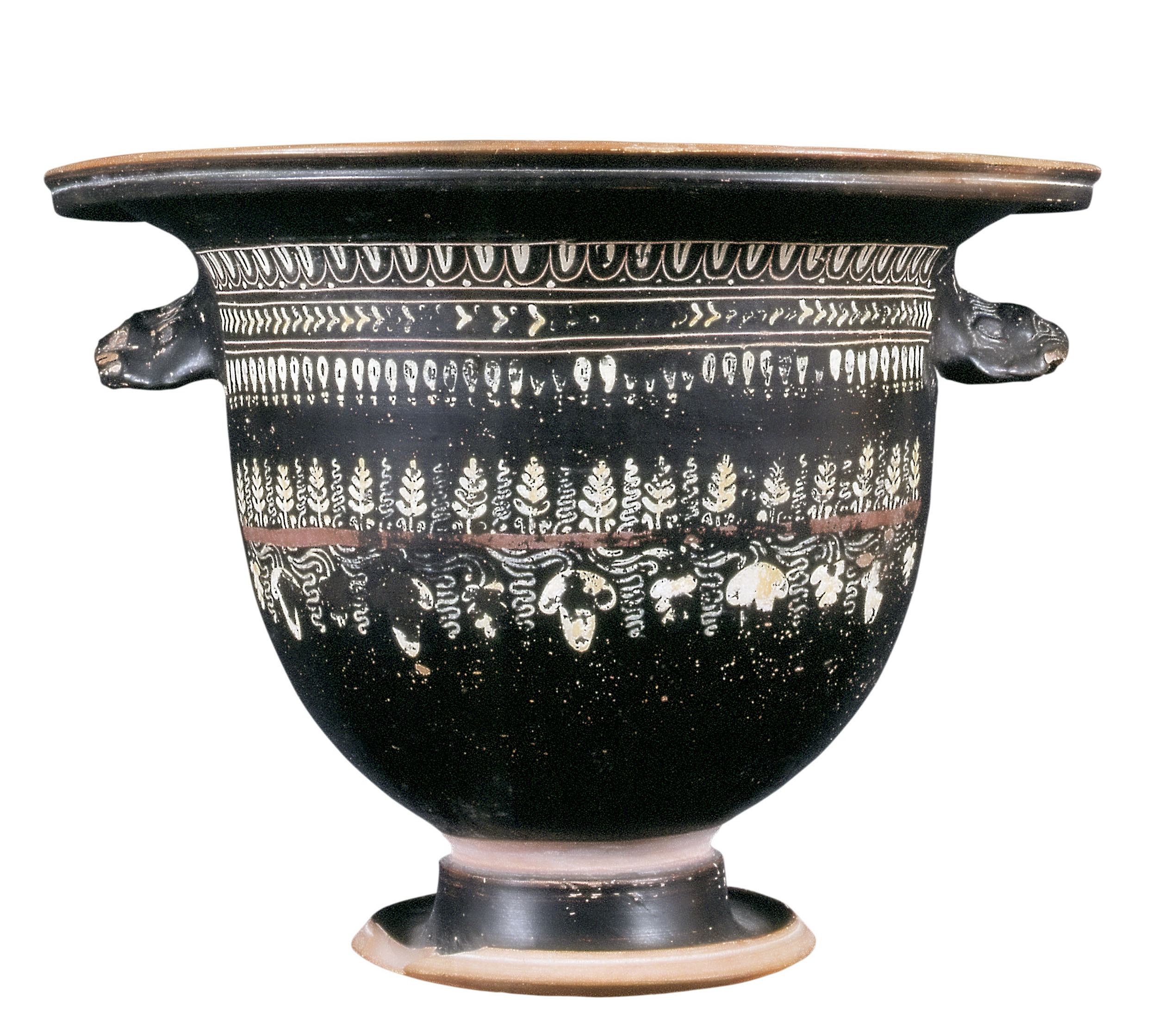

Κωδωνόσχημος κρατήρας τύπου Gnathia
Ο κρατήρας είναι διακοσμημένος στη μία μόνο όψη με τη χαρακτηριστική τεχνοτροπία των αγγείων τύπου Gnathia. Με πρόσθετο λευκό χρώμα αποδίδονται φυτικά και γραμμικά θέματα: Στην κοιλιά, κάτω από πλατιά ιώδη ταινία, φύλλα αμπέλου εναλλάσονται με κληματίδες και σχηματοποιημένα τσαμπιά. Πάνω, σειρά από φύλλα και κληματίδες. Στο λαιμό διπλές εγχάρακτες γραμμές διαχωρίζουν τρεις ζώνες με γραμμικά κοσμήματα. Μια λεπτή στρώση κίτρινου χρώματος, απολεπισμένη, σε μεγάλο βαθμό, διατηρείται πάνω στο λευκό.
Με τον όρο Gnathia είναι γνωστά τα κατωιταλιώτικα αντίστοιχα των αγγειων «δυτικής κλιτύος» της κυρίως Ελλάδας, τα οποία χαρακτηρίζονται από τη φυτική κυρίως διακόσμηση από διαλυμένο πηλό ή λευκό χρώμα πάνω στη μαύρη βαφή. Η ονομασία «γνάθια» είναι συμβατική και προέρχεται από το γεγονός ότι αγγεία της τεχνοτροπίας αυτής αποκαλύφθηκαν για πρώτη φορά στην πόλη Εγνατία (Egnazia) της Απουλίας, τη σημερινή Gnathia. Η παραγωγή τους αρχίζει λίγο πριν από τα μέσα του 4ου αι. π.Χ. (370-360 π.Χ.) στην Απουλία, με κυριότερο κέντρο τον Τάραντα, αργότερα όμως εξαπλώνεται σε όλα τα εργαστήρια της Κάτω Ιταλίας και της Σικελίας. Τα αγγεία «γνάθια», που το τέλος τους τοποθετείται στις τελευταίες δεκαετίες του 3ου αι. π.Χ., γνώρισαν ιδιαίτερη εξάπλωση στις αγορές της Δύσης, της Μαύρης Θάλασσας, της Βόρειας Αφρικής και του Ελλαδικού χώρου. Ο κρατήρας του Μουσείου Κανελλοπούλου είναι πιθανόν να κατασκευάστηκε στη Λουκανία αφού ο πλαγιαστός τρόπος που εκφύονται οι κληματίδες αμέσως κάτω από την ιώδη ταινία, είναι χαρακτηριστικό του ζωγράφου Ridola που είχε την έδρα του στην περιοχή αυτή (πρβλ με Green 2001, 64, εικ. 23).
ΔΗΜΟΣΙΕΥΣΗ
Ελευθεράτου Σ. 2006. Λήμμα καταλόγου αρ. 92, στο Χωρέμη-Σπετσιέρη Α. – Ζαρκάδας Α. (επιμ.), Μουσείο Παύλου και Αλεξάνδρας Κανελλοπούλου. Αρχαία Τέχνη, Αθήνα, 152-153.
